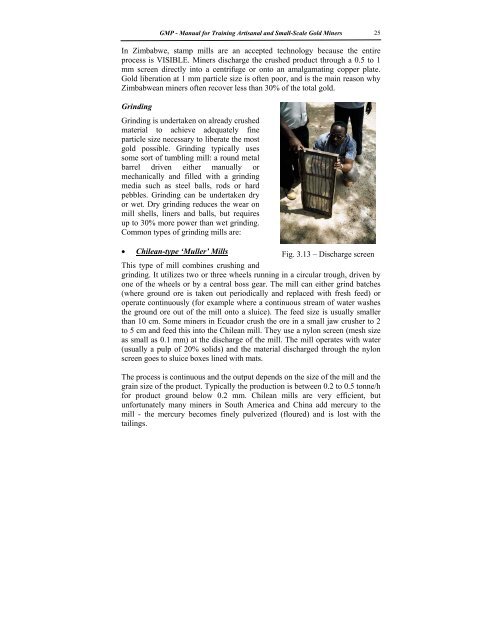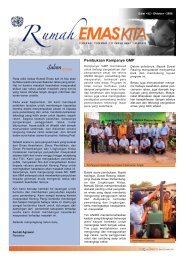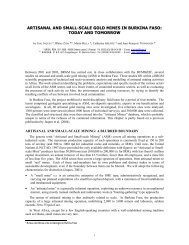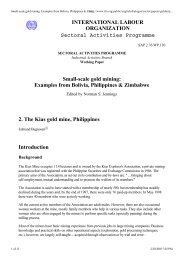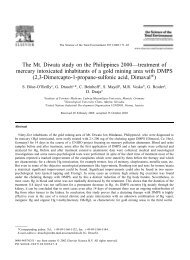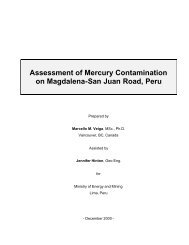Manual for Training Artisanal and Small-Scale Gold Miners
Manual for Training Artisanal and Small-Scale Gold Miners
Manual for Training Artisanal and Small-Scale Gold Miners
You also want an ePaper? Increase the reach of your titles
YUMPU automatically turns print PDFs into web optimized ePapers that Google loves.
GMP - <strong>Manual</strong> <strong>for</strong> <strong>Training</strong> <strong>Artisanal</strong> <strong>and</strong> <strong>Small</strong>-<strong>Scale</strong> <strong>Gold</strong> <strong>Miners</strong><br />
In Zimbabwe, stamp mills are an accepted technology because the entire<br />
process is VISIBLE. <strong>Miners</strong> discharge the crushed product through a 0.5 to 1<br />
mm screen directly into a centrifuge or onto an amalgamating copper plate.<br />
<strong>Gold</strong> liberation at 1 mm particle size is often poor, <strong>and</strong> is the main reason why<br />
Zimbabwean miners often recover less than 30% of the total gold.<br />
Grinding<br />
Grinding is undertaken on already crushed<br />
material to achieve adequately fine<br />
particle size necessary to liberate the most<br />
gold possible. Grinding typically uses<br />
some sort of tumbling mill: a round metal<br />
barrel driven either manually or<br />
mechanically <strong>and</strong> filled with a grinding<br />
media such as steel balls, rods or hard<br />
pebbles. Grinding can be undertaken dry<br />
or wet. Dry grinding reduces the wear on<br />
mill shells, liners <strong>and</strong> balls, but requires<br />
up to 30% more power than wet grinding.<br />
Common types of grinding mills are:<br />
• Chilean-type ‘Muller’ Mills<br />
Fig. 3.13 – Discharge screen<br />
This type of mill combines crushing <strong>and</strong><br />
grinding. It utilizes two or three wheels running in a circular trough, driven by<br />
one of the wheels or by a central boss gear. The mill can either grind batches<br />
(where ground ore is taken out periodically <strong>and</strong> replaced with fresh feed) or<br />
operate continuously (<strong>for</strong> example where a continuous stream of water washes<br />
the ground ore out of the mill onto a sluice). The feed size is usually smaller<br />
than 10 cm. Some miners in Ecuador crush the ore in a small jaw crusher to 2<br />
to 5 cm <strong>and</strong> feed this into the Chilean mill. They use a nylon screen (mesh size<br />
as small as 0.1 mm) at the discharge of the mill. The mill operates with water<br />
(usually a pulp of 20% solids) <strong>and</strong> the material discharged through the nylon<br />
screen goes to sluice boxes lined with mats.<br />
The process is continuous <strong>and</strong> the output depends on the size of the mill <strong>and</strong> the<br />
grain size of the product. Typically the production is between 0.2 to 0.5 tonne/h<br />
<strong>for</strong> product ground below 0.2 mm. Chilean mills are very efficient, but<br />
un<strong>for</strong>tunately many miners in South America <strong>and</strong> China add mercury to the<br />
mill - the mercury becomes finely pulverized (floured) <strong>and</strong> is lost with the<br />
tailings.<br />
25


